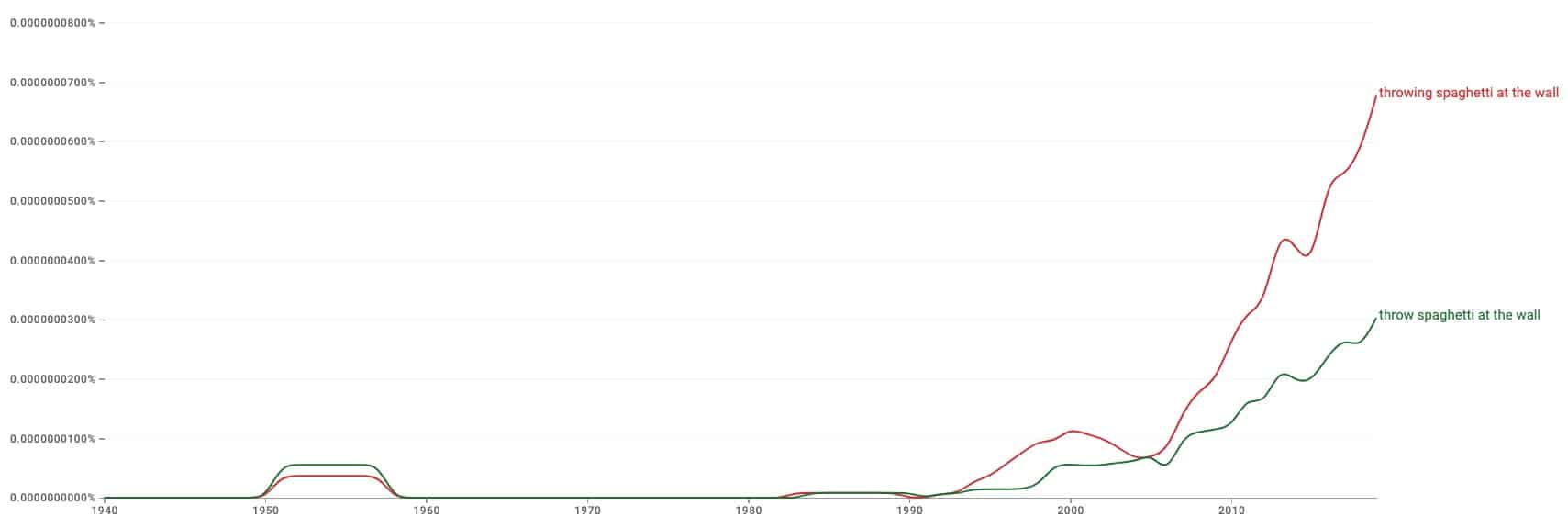Have you ever wondered what “throw spaghetti at the wall and see what sticks” means?
In short, throwing spaghetti at the wall to see what sticks means making numerous attempts or guesses, hoping one of them will succeed.

It’s often used to describe a trial-and-error approach to problem-solving, where many guesses or attempts are made in the hope that something will eventually work.
We will discuss the source and definition of this expression and how it is commonly used in daily conversations. Additionally, we will provide relevant samples to enhance your comprehension of the idiom.
Let’s start!
Throw Spaghetti at the Wall to See What Sticks: Meaning
The phrase “throwing spaghetti at the wall” metaphorically describes a haphazard approach to problem-solving. It refers to many diverse and often unrelated attempts to solve an issue without any real strategy or method.
It generally means trying several things simultaneously, hoping that at least one will work.
Applying this concept to your daily life, you’ll find the “throwing spaghetti at the wall” approach is often used in problem-solving, brainstorming, and decision-making. It suggests embracing a trial-and-error attitude when refining ideas and analysing potential outcomes.
It’s a bold approach to problem-solving that shows a willingness to take risks and explore multiple options to achieve success.
Now that you know the meaning, let’s look at the origin of this idiom.
Throwing Spaghetti at the Wall: Origin
The phrase “to throw spaghetti at the wall” originates from the “spaghetti test” or “wall test”, which is a popular method of checking whether spaghetti is cooked al dente by throwing it against a wall.
It’s often attributed to the Italian phrase “lanciare la pasta alla parete”, which translates literally to “throw pasta at the wall”.

The adage was first used in the early 1900s to describe a cook testing the doneness of pasta.
If the pasta stuck to the wall, it was done; if it didn’t, it wasn’t.

From there, the phrase morphed over time into a metaphor for any trial-and-error approach to problem-solving in which you make many attempts to second-guess what works without any real method or plan.

Usage in Writing and Speech (With Examples)
Throwing spaghetti at the wall is often used in business, creative endeavours, or when making decisions without a clear strategy, indicating a somewhat haphazard or experimental approach to problem-solving.
It implies that the person is casting a wide net, understanding that not everything will work out, but with the hope that something will indeed “stick” and provide a solution.
Let’s look at the specific uses in these settings:
Business and meetings
When you’re in a business meeting or brainstorming session, “throwing spaghetti at the wall” can be an effective way to generate various ideas. It means making multiple attempts at presenting ideas without worrying if they’re perfect or fully formed.
Imagine you’re in a meeting discussing new marketing strategies. Your colleague says:
“Let’s try throwing spaghetti at the wall with different ad designs and see which one gets the most engagement.”
In this context, they suggest you test multiple ad designs to see which works best.
Let’s look at another example:
During a brainstorming session, a team member suggests:
“We need some fresh ideas for the project, so let’s throw spaghetti at the wall and see what’s interesting.”
In this scenario, the colleague asks everyone to contribute ideas freely, hoping that some will be valuable and useful in driving the project forward.
“Throwing spaghetti at the wall” is often used to criticize someone for taking a chaotic approach to solving a problem. It implies that no real method or strategy is involved and that it’s simply a matter of trial and error.
For example, you might hear someone say:
“His approach to tackling the project was all over the place. He was just throwing spaghetti at the wall!”
In this sentence, the speaker criticises the other person for not having a methodical approach to problem-solving and instead trying many different things without any real thought or strategy.
Casual Setting
While chatting with a friend about dating, they offer some advice:
“Don’t be too picky at first; just throw spaghetti at the wall and see who you connect with.”
Here, your friend encourages you to be open to various potential romantic interests and see who you have the best connection with.
Here are a few more real-world examples of how you can use it in conversations or writing:
- “I’m not sure which marketing strategy to use, so I’m just throwing spaghetti at the wall to see what works.”
- “My boss always throws spaghetti at the wall and hopes something will stick.”
- “We tried a few different approaches to the problem, but it felt like we were just throwing spaghetti at the wall.”
- “I will try a few different things and see if they work. I guess you could say I’m throwing spaghetti at the wall.”
In each of these examples, the speaker/writer is using the idiom to describe a situation in which many different approaches are tried in the hopes of finding a successful solution.
Throw Spaghetti at the Wall: Synonyms
If you’re looking for alternative phrases for throwing spaghetti at the wall to spice up your writing, here are some related expressions:
Throw Enough Mud at the Wall
“Throw enough mud at the wall” is similar to “throwing spaghetti at the wall.” In this case, you’re trying various ideas or suggestions, hoping one will succeed. Like the spaghetti metaphor, the idea is that if you make enough attempts, one is bound to work eventually.
Trial and error
The phrase “trial and error” refers to trying out different strategies to solve a problem. This method is based on experimentation, which involves testing various tactics.
Casting a wide net
Casting a wide net is another expression similar to “throw spaghetti at the wall”. This phrase suggests casting out multiple ideas or solutions to find the best fit. Like throwing spaghetti, it encourages trying different methods until you get the desired result.
Fishing around
The expression “fishing around” means trying out multiple options until you find the best one. It’s comparable to testing different methods or approaches, like throwing spaghetti at the wall until you achieve the intended result.
Testing the waters
Testing the waters is similar to “throwing spaghetti at the wall” in that it involves trial and error, trying multiple solutions until you get the desired result.
Hit it (Right) on the Nose
“Hit it (right) on the nose” is another idiom you may come across. It means to be extremely accurate or precise with a statement or prediction. While this phrase doesn’t directly relate to “throwing spaghetti at the wall,” both idioms deal with the idea of trial and error, with the former implying numerous attempts and the latter signifying a single, successful one.
Throwing Spaghetti at the Wall: Wrapping Up
The idiom “throwing spaghetti at the wall” is a colourful way to describe a trial-and-error approach to problem-solving. It has become a popular expression in the English language and is often used in everyday conversation.
So the next time someone talks about throwing spaghetti at the wall, you’ll know exactly what they mean!
If you find the information in this post helpful, please consider subscribing for more useful tips and informative grammar lessons. You’re bound to come across something that can assist you in enhancing your grammar skills.
Now, will you subscribe or am I just throwing spaghetti at the wall trying to persuade you? 😉
Happy learning!
FAQs
What does throwing spaghetti at the wall mean?
“Throw spaghetti at the wall and see what sticks” is an informal way to describe taking a chance on multiple possibilities in the hope that one or more will prove successful. It embodies the spirit of experimentation and the willingness to be persistent in your efforts, even if some of them might not yield the desired outcome.
Where did throwing spaghetti at the wall come from?
The phrase “throwing spaghetti at the wall” is believed to have originated in Italy and is thought to be related to Italian culinary traditions. The idea is that if you throw a piece of spaghetti against a wall, it will stick if it is cooked enough. This phrase has been used as a metaphor for problem-solving since the early 20th century when it was first recorded in print.


